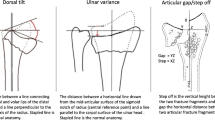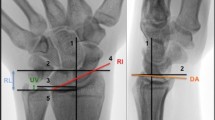Abstract
Introduction
The aim of this prospective, multicentre study was to evaluate the influence of local bone mineral density (BMD) on the rate of mechanical failure after locking plate fixation of closed distal radius fractures.
Materials and methods
Between June 2007 and April 2010, 230 women and 19 men with a mean age of 67 years were enrolled. Dual energy X-ray absorptiometry measurements for BMD of the contralateral distal radius were made at 6 weeks post-surgery. Follow-up evaluations at 6 weeks, 3 months and 1 year included wrist mobility and strength as well as standard radiographs. Any local bone/fracture or implant/surgery-related complications were documented. The Disability of the Arm, Shoulder, and Hand (DASH), Patient Rated Wrist Evaluation (PRWE), and EuroQol-5D scores were also recorded at the nominated time points.
Results
Nine patients were reported with mechanical failure at an estimated risk of 3.6 %. The BMD measurements were generally low for the study population with no difference between patients with (0.561 g/cm2) and without (0.626 g/cm2) mechanical failure (p = 0.148). None of the patients achieved their pre-injury functional level and quality of life status after 1 year. 1-year DASH and PRWE scores as well as the difference in maximum grip strength of the affected wrist relative to the contralateral side were significantly higher for patients with mechanical failure (p ≤ 0.036).
Conclusions
Our study could not identify a clear association between bone mineral density status and the risk of mechanical failure. Although the risk for mechanical failure after treatment of distal radius fractures with palmar locking plates is low, these complications must be avoided to prevent negative impact on long-term patient functional and quality of life outcome.
Similar content being viewed by others
References
Wigderowitz CA, Cunningham T, Rowley DI, Mole PA, Paterson CR (2003) Peripheral bone mineral density in patients with distal radial fractures. J Bone Joint Surg Br 85(3):423–425
Hung LK, Wu HT, Leung PC, Qin L (2005) Low BMD is a risk factor for low-energy Colles’ fractures in women before and after menopause. Clin Orthop Relat Res 435:219–225
Arora R, Lutz M, Fritz D, Zimmermann R, Oberladstatter J, Gabl M (2005) Palmar locking plate for treatment of unstable dorsal dislocated distal radius fractures. Arch Orthop Trauma Surg 125(6):399–404. doi:10.1007/s00402-005-0820-8
Musgrave DS, Idler RS (2005) Volar fixation of dorsally displaced distal radius fractures using the 2.4-mm locking compression plates. J hand surg 30(4):743–749. doi:10.1016/j.jhsa.2005.03.006
Orbay J (2005) Volar plate fixation of distal radius fractures. Hand Clin 21(3):347–354. doi:10.1016/j.hcl.2005.02.003
Drobetz H, Kutscha-Lissberg E (2003) Osteosynthesis of distal radial fractures with a volar locking screw plate system. Int Orthop 27(1):1–6. doi:10.1007/s00264-002-0393-x
Constantine KJ, Clawson MC, Stern PJ (2002) Volar neutralization plate fixation of dorsally displaced distal radius fractures. Orthopedics 25(2):125–128
Campbell DA (2000) Open reduction and internal fixation of intra articular and unstable fractures of the distal radius using the AO distal radius plate. J hand surg 25(6):528–534. doi:10.1054/jhsb.2000.0485
Rampoldi M, Marsico S (2007) Complications of volar plating of distal radius fractures. Acta Orthop Belg 73(6):714–719
Arora R, Lutz M, Hennerbichler A, Krappinger D, Espen D, Gabl M (2007) Complications following internal fixation of unstable distal radius fracture with a palmar locking-plate. J Orthop Trauma 21(5):316–322. doi:10.1097/BOT.0b013e318059b993
Harness NG, Jupiter JB, Orbay JL, Raskin KB, Fernandez DL (2004) Loss of fixation of the volar lunate facet fragment in fractures of the distal part of the radius. J Bone Joint Surg Am 86-A(9):1900–1908
Bell JS, Wollstein R, Citron ND (1998) Rupture of flexor pollicis longus tendon: a complication of volar plating of the distal radius. J Bone Joint Surg Br 80(2):225–226
Silman AJ (1995) The patient with fracture: the risk of subsequent fractures. Am J Med 98(2A):12S–16S
Wallace WA, Armstrong AL, Coupland C, Pye DW (1994) An investigation of the relationship between wrist fracture type and bone density in post-menopausal woman. In: Ring EFJ, Elvins DM, Bhalla AK (eds) Current research in osteoporosis and bone mineral measurement III. British Institute of Radiology, London, pp 33–34
Sangha O, Stucki G, Liang MH, Fossel AH, Katz JN (2003) The Self-Administered Comorbidity Questionnaire: a new method to assess comorbidity for clinical and health services research. Arthritis Rheum 49(2):156–163. doi:10.1002/art.10993
Müller ME, Nazarian S, Koch P, Schatzker J (1990) The Comprehensive Classification of Fractures of Long Bones. Springer-Verlag, Berlin
Gummesson C, Atroshi I, Ekdahl C (2003) The disabilities of the arm, shoulder and hand (DASH) outcome questionnaire: longitudinal construct validity and measuring self-rated health change after surgery. BMC Musculoskelet Disord 4:11. doi:10.1186/1471-2474-4-11
Offenbaecher M, Ewert T, Sangha O, Stucki G (2002) Validation of a German version of the disabilities of arm, shoulder, and hand questionnaire (DASH-G). J Rheumatol 29(2):401–402
MacDermid JC (1996) Development of a scale for patient rating of wrist pain and disability. J Hand Ther: Offici J Am Soc Hand Ther 9(2):178–183
MacDermid JC, Turgeon T, Richards RS, Beadle M, Roth JH (1998) Patient rating of wrist pain and disability: a reliable and valid measurement tool. J Orthop Trauma 12(8):577–586
Hemelaers L, Angst F, Drerup S, Simmen BR, Wood-Dauphinee S (2008) Reliability and validity of the German version of “the Patient-rated Wrist Evaluation (PRWE)” as an outcome measure of wrist pain and disability in patients with acute distal radius fractures. J Hand Ther: Off J Am Soc Hand Ther 21(4):366–376. doi:10.1197/j.jht.2008.03.002
EuroQol G (1990) EuroQol–a new facility for the measurement of health-related quality of life. Health Policy 16(3):199–208
Ryf C, Weymann A (1999) Range of Motion—AO Neutral-0 Method. Measurement and Documentation. AO Neutral-0 Methode. Messung und Dokumentation. Thieme, Stuttgart, New York
Goldhahn S, Kralinger F, Rikli D, Marent M, Goldhahn J (2010) Does osteoporosis increase complication risk in surgical fracture treatment? A protocol combining new endpoints for two prospective multicentre open cohort studies. BMC Musculoskelet Disord 11(1):256
Goldhahn J, Suhm N, Goldhahn S, Blauth M, Hanson B (2008) Influence of osteoporosis on fracture fixation—a systematic literature review. Osteoporos Int: J Establ Result Coop Between Eur Found Osteoporos Nat Osteoporos Found USA 19(6):761–772. doi:10.1007/s00198-007-0515-9
Arora R, Lutz M, Deml C, Krappinger D, Haug L, Gabl M (2011) A prospective randomized trial comparing nonoperative treatment with volar locking plate fixation for displaced and unstable distal radial fractures in patients sixty-five years of age and older. J Bone Joint Surg Am 93(23):2146–2153. doi:10.2106/JBJS.J.01597
Egol KA, Walsh M, Romo-Cardoso S, Dorsky S, Paksima N (2010) Distal radial fractures in the elderly: operative compared with nonoperative treatment. J Bone Joint Surg Am 92(9):1851–1857. doi:10.2106/JBJS.I.00968
Fitzpatrick SK, Casemyr NE, Zurakowski D, Day CS, Rozental TD (2012) The effect of osteoporosis on outcomes of operatively treated distal radius fractures. J Hand Surg 37(10):2027–2034. doi:10.1016/j.jhsa.2012.06.025
Cannada LK (2010) Commentary on an article by Egol KA et al: “distal radial fractures in the elderly: operative compared with nonoperative treatment”. J Bone Joint Surg Am 92(9):e11. doi:10.2106/JBJS.J.00681
Eckstein F, Lochmuller EM, Lill CA, Kuhn V, Schneider E, Delling G, Muller R (2002) Bone strength at clinically relevant sites displays substantial heterogeneity and is best predicted from site-specific bone densitometry. J Bone miner Res: Off J Am Soc Bone Miner Res 17(1):162–171. doi:10.1359/jbmr.2002.17.1.162
Acknowledgments
The authors would like to thank Nicole Steinfelder for valuable help in planning and managing the study, Monica Daigl for statistical analysis, Alexander Joeris for medical input and Melissa Wilhelmini and Andrea Sebald for copy-editing of this manuscript (all AO Clinical Investigation and Documentation). The authors on this paper are all: Research Partners of the Clinical Priority Program “Fracture fixation in osteoporotic bone FFOB” of AOTrauma Davos, Switzerland. The presented clinical investigation was performed with the support of the AO Foundation Network.
Conflict of interest
None.
Author information
Authors and Affiliations
Corresponding author
Rights and permissions
About this article
Cite this article
Daniel, R., Joerg, G., Kurt, K. et al. The effect of local bone mineral density on the rate of mechanical failure after surgical treatment of distal radius fractures: a prospective multicentre cohort study including 249 patients. Arch Orthop Trauma Surg 135, 201–207 (2015). https://doi.org/10.1007/s00402-014-2130-5
Received:
Published:
Issue Date:
DOI: https://doi.org/10.1007/s00402-014-2130-5




